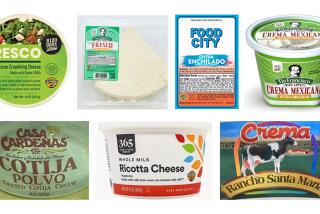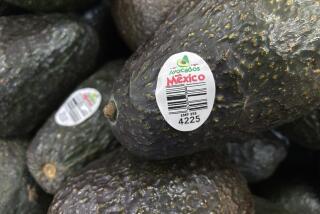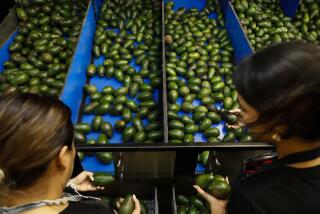Cyanide Traces Lead U.S. to Seize All Chilean Fruit
WASHINGTON — In an action that may virtually eliminate peaches, plums, nectarines and red seedless grapes from grocery shelves across the country, the federal government announced Monday that it is impounding all fruit imports from Chile after traces of cyanide were found in a shipment of Chilean grapes.
Government officials do not yet know how long the impoundment may last but warned that it could be for the remainder of the Chilean growing season, about five weeks. Chile is the nation’s leading supplier of winter non-citrus fruit and virtually the sole supplier of soft “tree fruits” such as peaches and plums.
Los Angeles-area grocers began to remove Chilean grapes from their shelves Monday night and were awaiting further word from the Food and Drug Administration on what other steps to take, said Jan de Lyser of the Fresh Produce Council in Los Angeles.
“There’s been some action already,” De Lyser said. “Whatever they direct will be complied with.”
Vickie Sanders, a spokeswoman for Vons stores, said the chain had not yet been officially informed of the FDA order but had made an “internal decision” to remove red seedless grapes from Chile from its shelves.
“What we’re trying to do now is prevent people from panicking,” Sanders said. “People see the word ‘cyanide’ and they may not notice that it’s two grapes out of a shipment of 300,000.”
FDA officials stressed that, so far, there is no evidence of further contamination beyond the one shipment of grapes that entered the country in Philadelphia a few days ago.
They noted also that, because cyanide is a quick-acting poison, consumers have no reason to worry about fruit they may already have eaten.
Two grapes in the shipment were found to have a low level of cyanide. The finding “may be an isolated incident,” FDA Commissioner Frank E. Young said. “But we can hardly take that chance.”
The FDA is advising grocers to remove Chilean fruit from their shelves. It is also asking consumers to check the source of any fresh non-citrus fruit they have at home and to discard any that may be of Chilean origin.
Store Removes Fruit
At a Ralphs market at Third Street and Vermont Avenue, stock clerks had removed grapes, blueberries and black plums from the shelves Monday afternoon, said store manager Carl Qudaimat.
“We pulled all the questionable things off as a precautionary measure,” he said. “It’s all sitting in the back.”
Lewis Stone, a consultant to Agriculture Export-Import USA, a downtown Los Angeles fruit and vegetable broker, said there are few alternative sources for the inexpensive and plentiful Chilean peaches, apricots, nectarines and plums that fill U.S. shelves during the winter.
Although Chilean fruit retails from about $1.50 per pound, alternatives like New Zealand fruit can sell for as much $5 per pound, Stone said.
“It’s going to affect the whole industry. The losses will be in the millions of dollars,” Stone predicted. “Fortunately, we didn’t have any (Chilean fruit) in the current shipment.”
California Crop in May
Stone predicted that most shoppers and retailers would wait to find substitutes for the Chilean fruit until May, when “early” California fruit would begin to be available.
Shoppers roaming the aisles of the produce section at a Vons in the Mid-Wilshire District reacted calmly to the news that some grapes and other non-citrus fruits had been pulled.
“It doesn’t seem to me like something to be concerned about,” said Maurice Smith as he walked out with a bag of strawberries and bananas, joking that it was “safe fruit.”
The FDA began checking Chilean imports earlier this month after an anonymous caller warned the U.S. Embassy in Chile that fruits being exported from that country had been poisoned. From March 2, when the call was made, until March 6, Chilean fruit was held up at entry ports by federal officials; but no sign of poison was found, so importing was resumed.
Originally, FDA spokesman Bill Grigg said, “the State Department advised us that the call was very probably a hoax.” But, after cyanide in the grape shipment was confirmed Sunday night, officials took the situation seriously.
The amount of cyanide found in the two grapes was too little to cause illness even in a child, Grigg noted. The grapes each contained .003 milligrams of the poison. A dose of 25 milligrams is needed to harm an adult, with 200 milligrams enough to cause death. Injury to children can be caused at lower doses, however.
Because cyanide deteriorates over time, FDA scientists warned that the original level of poison in the fruit may have been higher. The amount of poison, Grigg noted, could be higher in larger fruits, such as melons, or in less acidic fruits, because acidity causes the poison to break down more quickly.
The two grapes found to be contaminated were both punctured and discolored with a ring of a crystalline material around the puncture mark, Grigg said. FDA inspectors spotted them among thousands of grapes in hundreds of crates in a Philadelphia warehouse.
“If they had been turned the other way, they wouldn’t have seen them,” Grigg said.
The FDA plans to impound and test Chilean fruit until officials are confident that the fruit is safe, Grigg said. But, because that essentially means having to prove a negative--that there is no poison anywhere in the tons of fruit entering the country from Chile--the effect may be to block all Chilean imports for the rest of this season, he said.
“It’s a difficult thing to prove,” Grigg said. “We really don’t have a lot of experience in this area.”
“A lot of (fruit) will sit out on the boats” while FDA laboratories sample and analyze it, Grigg said.
The ban could represent a dramatic financial blow to the Chilean economy. Fruit exports have soared since the early 1980s, reaching $486.9 million in the first six months of 1988, which include the bulk of the growing season, and a total of $584.1 million for the entire year.
Table grapes are by far Chile’s most important fruit export, accounting for $280.8 million, followed by apples at $104.2 million, according to the Central Bank of Chile.
Interior Minister Carlos Caceres said early today that thousands of Chilean families will be hurt by the ban.
In an indication of the government’s concern over the matter, all television and radio stations were required to broadcast Caceres’ remarks shortly after midnight.
He noted that the Americans themselves had said that the amounts of cyanide discovered would not be enough to injure even a child, and said the Chilean government does not share the U.S. decision to impound the fruit “but understands the concern over their population’s health.”
Caceres said the government immediately reinforced security throughout the fruit production process, from the growing fields to the ports. He said a number of chemical tests had been conducted in recent hours and no abnormalities were discovered.
For the last several weeks, the major import from Chile has been the popular seedless red flame grapes. But, with grape season nearly over, the focus will shift to tree fruits such as peaches, plums and nectarines.
The next traditional source of supply for many of those varieties is California’s Coachella Valley, where harvests will not begin coming in until May, De Lyser said.
Staff writers John H. Lee and Hector Tobar in Los Angeles, and James F. Smith in Santiago, Chile, contributed to this story.
More to Read
Eat your way across L.A.
Get our weekly Tasting Notes newsletter for reviews, news and more.
You may occasionally receive promotional content from the Los Angeles Times.










